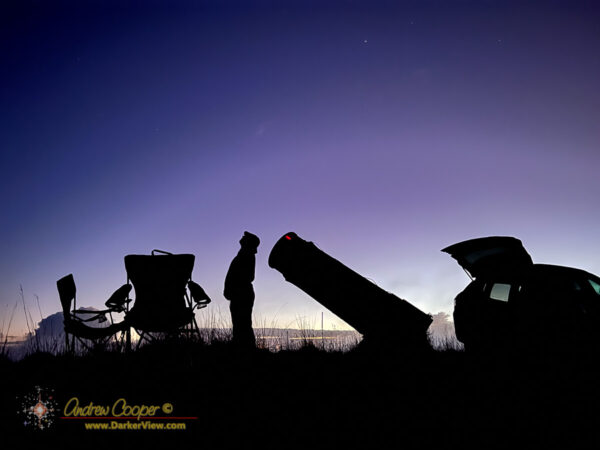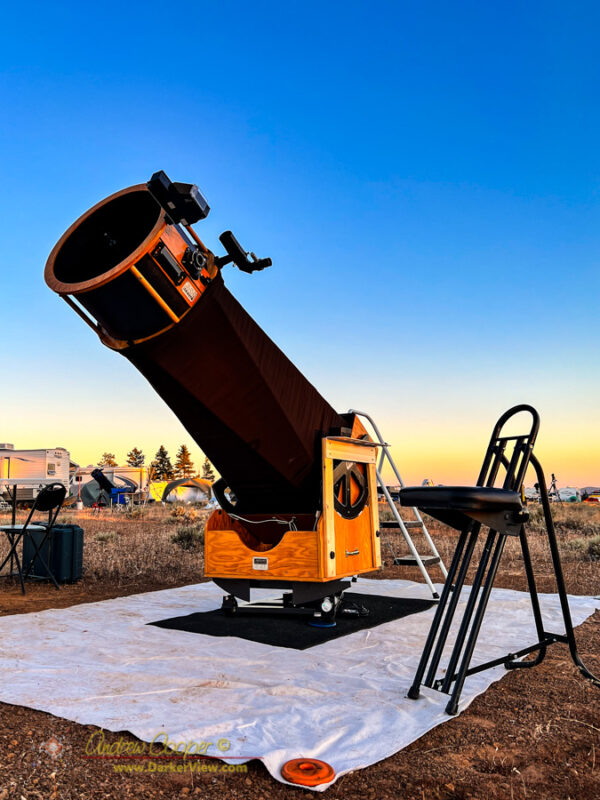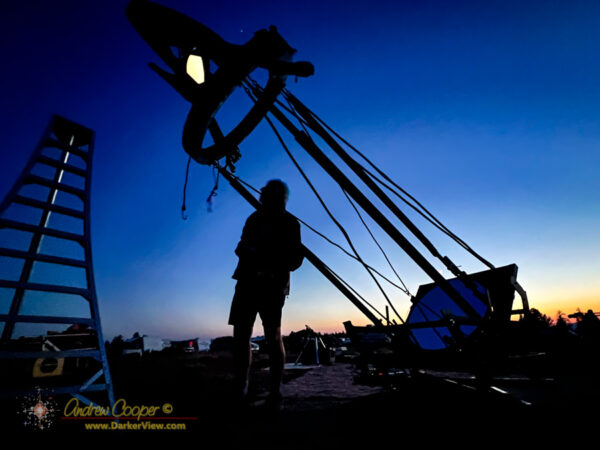
Awaiting Dark

When you want to see the stars, find someplace dark

While I have gotten plenty of telescope time lately, it has usually been morning sessions with the old Astrola in my driveway. This is a low effort and thoroughly enjoyable practice that I engage in about half a dozen times each month. Such sessions do mean that my 18″ telescope languishes for far too long in the garage.
I really need to change that.
Thus when my fellow staff at Symbrosia start asking for another star party it made a good excuse to get the big ‘scope out of the garage and under a dark sky.
Continue reading “A Misty Night at Kaʻohe”First quarter moon… Telescope time.
I find myself reliably rising early, often around 4am, something that seemed to have begun during the pandemic. Those who knew me in my younger years may find this a bit unbeliveable, I used to hate mornings, but now?
The other factoid about island mornings. It is almost always clear. The afternoon and evening clouds have dissipated and clear skies are the rule.
Combine these bits with a love of the sky and the result is morning observing sessions, often half a dozen mornings will be spent out with a telescope in those couple weeks the Moon is absent from the morning sky.
Get up, shrug on some ratty old clothes, and wheel the telescope out of the garage. The ‘scope of choice is almost always the old Astrola, even with larger and more sophisticated telescopes available there is just something about using that old manual ‘scope that I find satisfying.
Perhaps the lack of computer or digital setting circles means it is my own skill enabling my path among the stars. The Astrola does have manual setting circles, but I rarely use those. A star chart, a finder, and starhopping allow me to wander through rather than jump about… I just see more, often stumbling across unexpected bits of beauty.
I have upgraded the Astrola a bit lately, adding a larger finder ‘scope with a wide field eyepiece. It is a 50mm 3D printed finder of my own design allowing me to see more sky at once with fainter stars.
There are a few more days until the bright Moon crosses into the morning sky, a few more mornings you will likely find me out with the ‘scope.
The ZWO AM5 telescope mount is a great piece of kit… It integrates very well with software allowing easy computer control, just click and go. The mount tracks wonderfully allowing excellent astrophotos. It is small, does not require a counterweight for smaller ‘scopes, and precise polar alignment is a breeze.
The mount is not without issues… Without a camera integrated into the system the GOTO accuracy is awful, using the mount as a visual mount is frustrating. You really need to have at least a guide camera and the ASI Air computer connected to allow to plate solving and automatic correction of the position at the end of each slew to a new target.
Another issue is that the mount has no concept of cord wrap. It will happily spin around and around as you wander across the sky. In equatorial mode this is not an issue, in alt-azimuth mode this runs the risk of damaging your equipment if you do not notice the power cord getting wrapped up on the mount in the dark.
Yes, I did that.
Continue reading “A Battery Caddy for the AM5”
A dark clear night at Kaʻohe, just the thing I needed. A telescope… A dark sky.
There had been plans of a few friends from work, but with a virus rampaging through the crew a social event did not seem like a great idea. Will have to do the invitations another time. This evening would be a solo run.
No big production… Toss the gear in the vehicle… The Nexstar 11″ ‘scope, a few munchies and a thermos of hot tea, a table, a notebook, and go.
The night was nearly perfect, no wind, not all that cold, a few wisps of cloud that dissipated after sunset.
I would work the southern horizon this night, as low as I can go from 20°N latitude. From the Kaʻohe site due south is right over the summit of Mauna Loa. Just above the shadowy outline of the caldera I would catch stars and galaxies as they transited. Constellations unknown and inaccessible to northern observers… Pavo, Grus, and Phoenix. Some of the objects I observed were in the lower -60° declinations…
φ2 Pav Pale yellow, no companion noted, φ1 Pav is visible 33′ west
Andrew Cooper, 7 Oct 2023
NGC 7582 Bright and obvious, extended 5′ x 2′ northwest-southeast, brighter to the center without a notable core, NGC 7590 and NGC 7599 visible 10′ northeast, NGC 7552 visible 28′ southwest, the Grus Quartet makes an entrancing field with four bright galaxies
NGC 45 Quite faint and diffuse, difficult, about 5′ diameter, a slight brightening to the center, a 10th magnitude star in the southeast quadrant, the 7th magnitude star HD 941 is about 5′ southwest
NGC 7155 Small, faint, round with a stellar core, at the center of an east-west 15′ arc of 11th to 12th magnitude stars
A good night out with a telescope, packing it in about midnight as to not totally wreck my sleep pattern. Still, I got in five hours of observing.
Leaking alkaline batteries, the bane of our portable, battery powered existence. All too many times I have found myself repairing electronic devices damage by leaking batteries, or just junking the gear when the damage is too severe.
This time the device in question was just a bit too valuable to dispose of despite fairly extensive damage.
A Celestron Nexstar 8SE telescope.
Continue reading “Battery Corrosion Again”